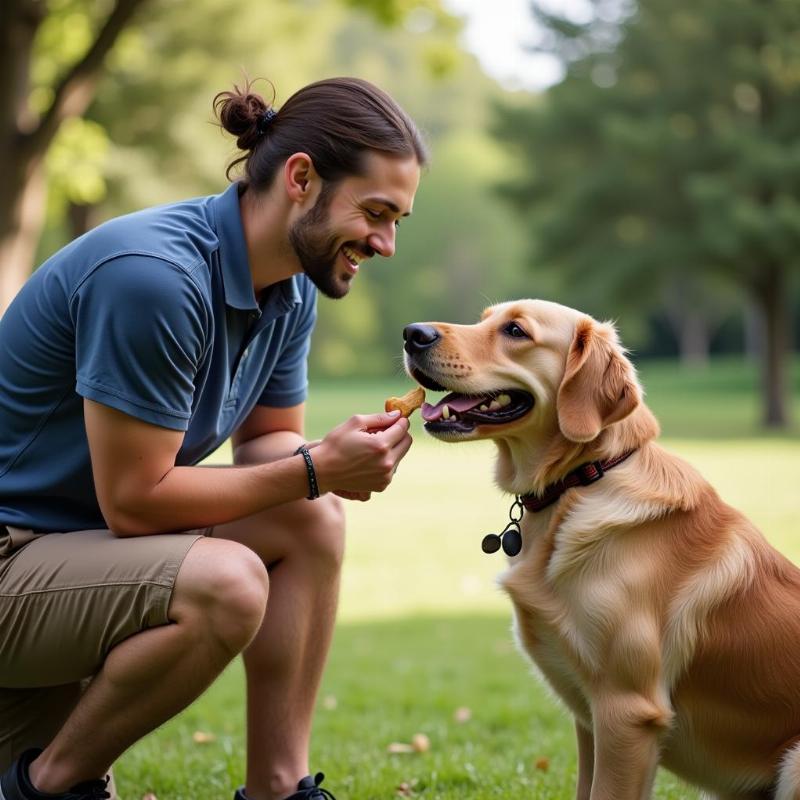Using live pigeons for dog training, particularly for breeds like greyhounds or raptors, is a complex and often controversial topic. While some trainers argue for its effectiveness in stimulating prey drive, ethical concerns and legal restrictions in many US states often make it a challenging practice. This article explores the nuances of using pigeons for dog training, offering alternatives and emphasizing humane training methods.
Understanding the Appeal and Concerns of Using Pigeons
Historically, pigeons have been used in training hunting dogs and birds of prey. The fluttering movement and natural instinct to flee trigger a dog’s prey drive, which some trainers believe can enhance performance in specific activities like lure coursing or falconry. However, animal welfare is a paramount concern. The use of live animals for training raises ethical questions about potential harm and stress inflicted on the pigeons. Furthermore, many states have specific regulations or outright bans on using live animals for this purpose. It’s crucial to research and adhere to local laws before considering this training method.
Alternatives to Live Pigeons for Dog Training
Fortunately, several effective and humane alternatives to live pigeons exist. Lure coursing, as mentioned earlier, utilizes a mechanical lure that mimics the movement of a bird, providing a safe and ethical way to stimulate a dog’s prey drive. Other options include flirt poles, which are long poles with a lure attached to the end, and even simple toys like squeaky toys or balls can be used to engage a dog’s natural instincts in a positive way. These methods not only eliminate the ethical concerns associated with using live animals, but they also offer greater control over the training process, allowing for tailored exercises that build focus and control.
Focusing on Positive Reinforcement Techniques
Regardless of the training method, positive reinforcement is key to effective and ethical dog training. Rewarding desired behaviors with treats, praise, or toys creates a positive association and encourages the dog to repeat those behaviors. This approach builds a strong bond between dog and owner and fosters a positive learning environment. Avoid punishment-based training methods, which can damage the dog’s trust and create anxiety.
Building a Strong Foundation through Basic Obedience
Before introducing any advanced training techniques, a solid foundation in basic obedience is crucial. Commands like “sit,” “stay,” “come,” and “leave it” are essential for establishing control and communication with your dog. This foundation provides the framework for more complex training and ensures your dog can respond reliably in various situations.
Legal and Ethical Considerations in Dog Training
When exploring different training methods, understanding the legal and ethical landscape is paramount. Research your state’s specific regulations regarding the use of live animals in dog training. Consult with a professional dog trainer or veterinarian for guidance on ethical and effective training practices.  Dog trainer using positive reinforcement Prioritizing your dog’s well-being and adhering to ethical training principles ensures a positive and productive training experience for both you and your canine companion.
Dog trainer using positive reinforcement Prioritizing your dog’s well-being and adhering to ethical training principles ensures a positive and productive training experience for both you and your canine companion.
FAQ
- Is it legal to use live pigeons for dog training in the US? The legality varies by state; always check your local regulations.
- What are the ethical concerns surrounding the use of live pigeons? The potential for harm and stress to the pigeons raises significant ethical concerns.
- What are some effective alternatives to using live pigeons? Lure coursing, flirt poles, and even basic toys can effectively engage a dog’s prey drive.
- Why is positive reinforcement important in dog training? Positive reinforcement builds a positive learning environment, strengthens the dog-owner bond, and encourages desired behaviors.
- What are the essential basic obedience commands for a dog? “Sit,” “stay,” “come,” and “leave it” are fundamental commands for establishing control and communication.
Find More Helpful Dog Training Tips on Beautdogs.us
About Beautdogs.us
Beautdogs.us is your premier online destination for all things dog-related in the US. We offer expert advice on dog breeds, care, training, and product reviews. Whether you’re a seasoned dog owner or just starting out, Beautdogs.us provides trustworthy resources and guidance. For more information, contact us at [email protected] or call us at +1 501-555-7529. Connect with us today and discover a world of information at Beautdogs.us.